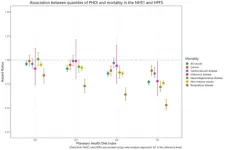(Press-News.org) Children and adolescents living in food-insecure households had a 55% higher frequency of physician visits for mental health reasons than those with adequate food supplies, according to new research published in CMAJ (Canadian Medical Association Journal) https://www.cmaj.ca/lookup/doi/10.1503/cmaj.230332.
In 2021, almost 6 million people Canada, including 1.4 million children and adolescents younger than 18 years faced food insecurity; that is, inadequate food intake because of financial problems.
The study looked at population health survey data from the Canadian Community Health Survey on 32,321 children and adolescents linked to Ontario health care data. Researchers used a validated measurement tool to categorize household food access as food-secure, marginally food-insecure, moderately food-insecure, or severely food-insecure.
Of the total, 5216 (16.1%) were living in food-insecure, 1952 (6.0%) in marginally food-insecure, 2348 (7.3%) in moderately food-insecure and 916 (2.8%) in severely food-insecure households.
Researchers also found that children and adolescents in food-insecure homes had a 74% higher prevalence of past-year acute care visits, defined as an emergency department visit or hospitalization for a mental or substance use disorder. The most common visits were for neurodevelopmental disorders, mood and anxiety disorders followed by social problems and other mental health issues.
“The coexistence of household food insecurity and service use for mental and substance use disorders here is problematic, given that both of these conditions have each been found to have negative consequences for social, educational and developmental outcomes among children and adolescents,” writes Kelly Anderson, associate professor of epidemiology and biostatistics at Western University's Schulich School of Medicine & Dentistry, Canada Research Chair in public mental health research, and adjunct scientist at ICES Western.
“Taken together, these findings are concerning, and we need strong public policy to support families who face food insecurity,” says senior author Salimah Shariff, staff scientist at ICES Western. “As well, public mental health strategies must be improved and targeted to youth specifically to help reduce the strain on the public mental health system.”
The authors note that the findings may not apply to First Nations groups and people in remote regions where food insecurity is particularly high, or to jurisdictions beyond Ontario. The data are also almost a decade old, and food insecurity has increased in recent years, especially during the COVID-19 pandemic.
The relationship between food insecurity and mental health issues may be more complicated, as a https://www.cmaj.ca/lookup/doi/10.1503/cmaj.230849 suggests.
“Given the diverse mental health conditions examined, it is unlikely that the mechanism of harm is lack of specific nutrients or poor diet quality,” writes Dr. Lynn McIntyre, Professor Emerita of Community Health Sciences, Cumming School of Medicine, University of Calgary, Calgary, Alberta. “Much more likely is that food insecurity contributes to mental distress among those living in difficult circumstances, as has been shown in studies of the relationship between severity of household food insecurity and mental health disorders among adults.”
Reducing food insecurity may help alleviate some mental health issues for children and youth.
“Clinicians should advocate as vociferously about the need for income security for families who are food-insecure as they do for solutions to emergency departments being filled with patients who need primary health care. Some jurisdictions have proposed that practitioners screen patients for financial strain and take steps to ensure that those identified as such receive their financial entitlements,” concludes Dr. McIntyre.
END
Children and adolescents in food-insecure homes had more mental health visits
2023-07-24
ELSE PRESS RELEASES FROM THIS DATE:
Gene conferring novel function to seahorse brood pouch identified
2023-07-24
Teleost fish encompass a diverse group, among which seahorses display a unique morphology. The characteristic spines and brood pouch seen in seahorses feature distinctive epithelial cells—called flame cone cells—covered by a mucous cap. However, these cells are not found in the barbed pipefish Urocampus nanus or the seaweed pipefish Syngnathus schlegeli, close relatives of the seahorse, belonging to the Syngnathidae lineage. While research has hypothesized the function of the flame cone cells, their evolutionary origins have remained a mystery.
Now, a team of scientists led by Assoc. Prof. Mari Kawaguchi and Prof. Shigeki Yasumasu from the Department of Materials ...
Two in three cosmetic surgery injections in the UK are not administered by doctors
2023-07-24
According to an analysis of the UK’s cosmetic injectables industry by UCL researchers, 68% of cosmetic practitioners who are administering injections such as Botox are not qualified medical doctors.
The study, published in the Journal of Plastic, Reconstructive & Aesthetic Surgery, is the first survey of who is providing cosmetic injectable services, such as Botulinum Toxin (Botox) and Dermal Fillers, in the UK. Currently, little is known about the background qualifications, training and experience levels of those who are administering treatments.
To fill this ...
A whole new dimension for 3D printing
2023-07-24
3D printing of complex objects typically takes a long time due to the printing process necessarily laying down a large number of 2D layers to build up the object. The process usually wastes a lot of material required to support the unfinished object. Some novel ways to make flat materials self-fold into 3D shapes exist, but have shortcomings. For the first time, researchers combined 2D printing, origami, and chemistry to create a method of rapid 3D object fabrication without creating any waste material. These shapes self-fold in seconds.
For some time, 3D printing has been used to prototype ...
MIND diet linked with better focus in school-aged children
2023-07-23
A diet originally designed to help ward off cognitive decline in adults might also help improve attention in pre-adolescents, according to a new study. The findings could help inform future dietary interventions aimed at improving cognition in children.
The new study examined two diets: the Healthy Eating Index – 2015 (HEI-2015), which is based on the Dietary Guidelines for Americans, and the Mediterranean-DASH Intervention for Neurodegenerative Delay (MIND) diet, which combines the Mediterranean diet with the heart-healthy Dietary Approaches to Stop Hypertension ...
These foods can help you live longer and protect the planet
2023-07-23
Eating more planet-friendly foods could help you live a longer, healthier life, according to new research. Researchers found that people who followed a more environmentally sustainable diet were 25% less likely to die during a follow-up period of over 30 years compared to those with a less sustainable diet.
The study builds upon prior research that identified foods that are a win-win for both health and the environment—such as whole grains, fruit, non-starchy vegetables, nuts, and unsaturated oils—as well as foods that could be harmful to the environment and human health, like eggs ...
Many children in rural areas receive high salt and sugar foods before age 2
2023-07-23
A study of over 10,000 children in rural Pennsylvania revealed that a large proportion of children were fed foods that are high in sugar and salt in their first years of life.
Over half (53%) of the children in the study received high-sodium meats such as hot dogs, 37% received salty snacks such as potato chips, and one-third (34%) received cakes, cookies, or pudding before age 2. In addition, over one-quarter (27%) of babies received juice before their first birthday.
“Given ...
The Lancet: People on ART with low but detectible levels of HIV viral load have almost zero risk of sexually transmitting the virus to others, in-depth review suggests
2023-07-23
Systematic review of 8 studies in more than 7,700 serodiscordant couples in 25 countries finds people living with HIV with viral loads less than 1,000 copies/mL have almost zero risk of transmitting the virus to their sexual partners. Previous studies have not been able to confirm a lack of transmission risk above 200 copies/mL.
Systematic review also consolidates and reinforces previous studies that have found there is zero risk of transmitting the virus to sexual partners when people living with HIV have an undetectable viral load.
Of the more than 320 documented sexual HIV transmissions ...
Researchers identify genes that directly influence what we eat
2023-07-22
In one of the first large-scale studies of genes related to diet, researchers have uncovered almost 500 genes that appear to directly influence the foods we eat. The findings represent an important step toward using a person’s genetics to develop precision nutrition strategies that help improve health or prevent disease.
“Some genes we identified are related to sensory pathways — including those for taste, smell, and texture — and may also increase the reward response in the brain,” said research team leader Joanne Cole, PhD, assistant professor in the Department ...
Scientists name top five foods rich in prebiotics
2023-07-22
There is growing evidence that consuming prebiotics — certain types of fiber often found in plants that stimulate beneficial bacteria in your gut — can help to maintain a healthy gut microbiome. In a new study, scientists estimated the prebiotic content of thousands of food types by using preexisting literature to find out which foods offer the highest prebiotic content.
According to the study, foods that pack the greatest prebiotic punch are dandelion greens, Jerusalem artichokes, garlic, leeks, and onions. In addition to supporting gut microbes, prebiotic rich ...
A defense against attacks on unmanned ground and aerial vehicles
2023-07-22
A University of Texas at Arlington engineering researcher is working on defenses that could thwart cyberattacks against networks of self-driving cars and unmanned aerial vehicles.
Animesh Chakravarthy, associate professor in the Department of Mechanical and Aerospace Engineering (MAE), is the principal investigator on an approximately $800,000 U.S. Department of Defense grant titled “Resilient Multi-Vehicle Networks.” MAE Professor Kamesh Subbarao, and Bill Beksi, assistant professor ...





